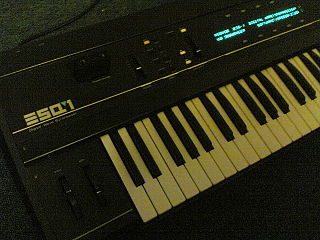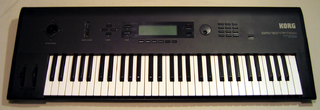The Nord Lead is a series of virtual analog subtractive synthesizers, manufactured by Clavia.

Ensoniq ESQ-1 is a 61-key, velocity sensitive, eight-note polyphonic and multitimbral synthesizer released by Ensoniq in 1985. It was marketed as a "digital wave synthesizer" but was an early Music Workstation. Although its voice generation is typically subtractive in much the same fashion as most analog synthesizers that preceded it, its oscillators are neither voltage nor "digitally controlled", but true digital oscillators, provided by a custom Ensoniq wavetable chip. The signal path includes analog resonant low-pass filters and an analog amplifier.
The Yamaha AN1x is a DSP-based analog modeling synthesizer, produced by Yamaha Corporation from 1997 to 1998, and was marketed as an "analog physical modelling control synthesizer".

The Korg OASYS is a workstation synthesizer released in early 2005, 1 year after the successful Korg Triton Extreme. Unlike the Triton series, the OASYS uses a custom Linux operating system that was designed to be arbitrarily expandable via software updates, with its functionality limited only by the PC-like hardware.

The Realistic Concertmate MG-1 is an analog synthesizer manufactured by Moog Music in 1981 and sold by Radio Shack from 1982 to 1983 under their "Realistic" brand name. It was produced without some standard Moog features, such as pitch and modulation wheels, as a cost-cutting measure aimed at achieving a lower price for the consumer market. The synthesizer also featured a pair of pass-through RCA jacks, which allowed users to mix radio or records into the final live synthesized sound output.

The microKORG is a MIDI-capable digital synthesizer/vocoder from Korg featuring DSP-based analog modelling. The synthesizer is built in such a way that it is essentially a Korg MS-2000 with a programmable step arpeggiator, a less advanced vocoder, lack of motion sequencing, lack of an XLR microphone input, and in a smaller case with fewer real-time control knobs.

The Korg DW-8000 synthesizer is an eight-voice polyphonic hybrid digital-analog synthesizer 61-note keyboard instrument released in 1985. By the time of its launch, Korg had already begun a common trend in 1980s synthesizer design: using numerical codes to access or change parameters with its predecessor - the Korg Poly-61, which was widely regarded as the company's first "knobless" synthesizer. This was a move away from the heavily laden, complex control panels of earlier designs.

The Access Virus is a virtual analog synthesizer made by the German company Access Music GmbH. It was first produced in 1997 and has since been upgraded frequently, with the company releasing new models about every two years. Early models include the Virus A, Virus B, and Virus C series, each available in various hardware configurations. In November 2005, the Virus TI series was released, including the 61-key Virus TI Keyboard and the 37-key Virus TI Polar. A small desktop model was released in February 2008 called the Virus TI Snow. A revision of the TI series called TI2 came out in March 2009, featuring faster digital signal processing (DSP) controllers, additional polyphony, more effects in the effect section and a slightly changed design. The Virus series also has come out with two software plugin versions: TDM for Pro Tools and VST for TC Electronic Powercore series. The term Access Virus can be used to refer to any one of these synthesizers.

The Korg MS2000 is a virtual analog synthesizer produced by the Japanese electronic musical instrument manufacturer Korg.

The Korg Wavestation is a vector synthesis synthesizer first produced in the early 1990s and later re-released as a software synthesizer in 2004. Its primary innovation was Wave Sequencing, a method of multi-timbral sound generation in which different PCM waveform data are played successively, resulting in continuously evolving sounds. The Wavestation's "Advanced Vector Synthesis" sound architecture resembled early vector synths such as the Sequential Circuits Prophet VS.
The Ensoniq TS-10 was a synthesizer and music workstation introduced by Ensoniq in 1993. It provided synthesis, user sample playback, sequencer, effect units and performance facilities in a 61-key package.
The Nord Stage is a digital keyboard or stage piano, manufactured by Clavia Digital Music Instruments of Stockholm, Sweden. There have been six editions of the instrument: the original Nord Stage in 2005, the Nord Stage EX in 2008, the Nord Stage 2 in 2011, the Nord Stage 2 EX in 2015, the Nord Stage 3 in 2017, and the Nord Stage 4 in 2023.

The Oberheim OB•12 is a Virtual Analog synthesizer, designed and realised by the Italian musical instrument manufacturer Viscount, in production between 2000 and 2005.
The Korg DSS-1 is a 12-bit polyphonic sampling synthesizer released in September 1986. It came out at a time when many of the popular synthesizer companies were beginning to get into sampling, an area of sound design that had previously been left to a handful of fledgling companies such as Fairlight, E-mu, and Ensoniq. Like Yamaha and Casio, however, Korg did not stay long in the sampling arena. The DSS-1 was the company's only sampler until 1998 when Korg introduced sampling options on their Triton and Trinity series of workstations, and on their Electribe series of drum-and-phrase samplers.

A synthesizer is an electronic musical instrument that generates audio signals. Synthesizers typically create sounds by generating waveforms through methods including subtractive synthesis, additive synthesis and frequency modulation synthesis. These sounds may be altered by components such as filters, which cut or boost frequencies; envelopes, which control articulation, or how notes begin and end; and low-frequency oscillators, which modulate parameters such as pitch, volume, or filter characteristics affecting timbre. Synthesizers are typically played with keyboards or controlled by sequencers, software or other instruments and may be synchronized to other equipment via MIDI.

The Evolver is an analog-digital hybrid synthesizer designed by Dave Smith and manufactured by Dave Smith Instruments. It was first released as a desktop version in 2002, then later a 37-key keyboard bearing the same synth engine as the Evolver desktop was also released. A polyphonic version of the Evolver, dubbed the Poly Evolver, was released in 2004 as a rackmount version, then a 61-key keyboard version of the Poly Evolver was released in 2005. The Evolvers were replaced by new high end models, the Prophet 12 and the Pro 2.

The Korg RADIAS is a virtual analog synthesizer and Vocoder, released by Korg in 2006. The RADIAS' MMT engine was based on the Korg OASYS synthesizer module, providing for several different synthesis methods, two of which may be combined in a single voice e.g. phase distortion synthesis can be combined with subtractive synthesis. The different synthesis methods employed by MMT represent the majority of methods used historically in other Korg synthesizers: digital waveguide synthesis Korg first used in the Korg Z1 and phase distortion synthesis was first used in the Korg DS-8. This flexibility allows for very realistic emulations of past Korg synthesizers, though stays away from trying to emulate the Korg M1 and the Korg Wavestation,. As well as using the in-built waveforms for the basis of sound creation, the RADIAS allows for the input of an external signal which may be routed through the various sound shaping devices. The RADIAS has a comprehensive matrix modulation specification and to further enhance a sound the 'Wave Shaper' module allows for various sound distortion effects.

The AX60 is a polyphonic analogue keyboard synthesizer manufactured by Akai Professional in the mid-1980s. It was Akai's answer to the popular Roland Juno series synthesizers. The AX60 uses voltage-controlled analogue oscillators and filter circuitry based on the Curtis Electronics CEM 3394 integrated circuit.

The CZ series is a family of low-cost phase distortion synthesizers produced by Casio in the mid-1980s. Eight models of CZ synthesizers were released: the CZ-101, CZ-230S, CZ-1000, CZ-2000S, CZ-2600S, CZ-3000, CZ-5000, and the CZ-1. Additionally, the home-keyboard model CT-6500 used 48 phase distortion presets from the CZ line. The CZ synthesizers' price at the time of their introduction made programmable synthesizers affordable enough to be purchased by garage bands. Yamaha soon introduced their own low-cost digital synthesizers, including the DX-21 (1985) and Yamaha DX100, in light of the CZ series' success.

Synth1 is a software synthesizer designed by KVR user Daichi. It was originally designed as an emulation of the Nord Lead 2 synthesizer, and has since become a unique Virtual Studio Technology instrument and one of the most downloaded VST plug-ins of all time. The software used to be a DirectX instrument plugin, but became solely VSTi from version 1.08 on. Version 1.13 was the first version to introduce a native 64-bit version of the plugin.














